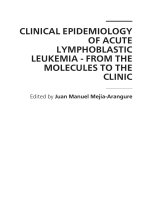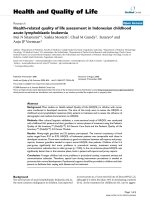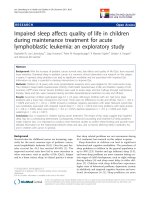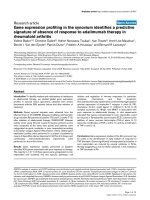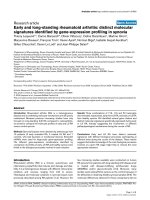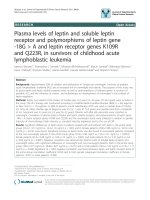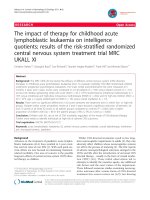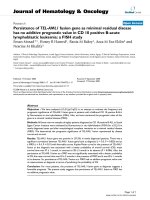Relapse prediction in childhood acute lymphoblastic leukemia by time series gene expression profiling
Bạn đang xem bản rút gọn của tài liệu. Xem và tải ngay bản đầy đủ của tài liệu tại đây (4.81 MB, 141 trang )
RELAPSE PREDICTION IN CHILDHOOD ACUTE
LYMPHOBLASTIC LEUKEMIA BY TIME-SERIES
GENE EXPRESSION PROFILING
DIFENG DONG
NATIONAL UNIVERSITY OF SINGAPORE
2011
RELAPSE PREDICTION IN CHILDHOOD ACUTE
LYMPHOBLASTIC LEUKEMIA BY TIME-SERIES GENE
EXPRESSION PROFILING
DIFENG DONG
(B. COMP., FUDAN UNIVERSITY)
A THESIS SUBMITTED FOR THE DEGREE OF
DOCTOR OF PHILOSOPHY
DEPARTMENT OF COMPUTER SCIENCE
NATIONAL UNIVERSITY OF SINGAPORE
2011
i
ACKNOWLEDGEMENT
First and foremost, I thank my mentor, Prof. Limsoon Wong, for investing huge amount of time
in advising my doctoral work. His great support in both spirit and finance allows me to follow my
own heart in research and to eventually complete this thesis.
I thank Dario Campana, Elaine Coustan-Smith, Shirley Kham, Yi Lu, and Allen Yeoh for
sharing the invaluable data with me.
I thank my friends since college, Su Chen, Dong Guo, Hao Li, Bin Liu, Yingyi Qi, Brian
Wang, Vicki Wang, Ning Ye, and Jay Zhuo, for spending good time with me.
I thank my friends, Yexin Cai, Jin Chen, Tsunghan Chiang, Kenny Chua, Mornin Feng, Zheng
Han, Chuan Hock Koh, Xiaowei Li, Yan Li, Bing Liu, Guimei Liu, Yuan Shi, Donny Soh, Junjie
Wang, Hugo Willy, Lu Yin, and Boxuan Zhai, for sharing happiness with me.
I thank my wife, Peipei, for whatever she has done for me. I would not be able to finish this
thesis without her support.
ii
SUMMARY
Childhood acute lymphoblastic leukemia (ALL) is the most common type of cancer in children.
Contemporary management of patients with childhood ALL is based on the concept of tailoring
the intensity of therapy to a patient’s risk of relapse, thereby maximizing the opportunity of cure
and minimizing toxic side effects. However, practical protocols of relapse prediction remain
imperfect. A significant number of patients with good prognostic characteristics relapse, while
some with poor prognostic features survive. There is a demand to improve relapse prediction.
High-throughput gene expression profiling (GEP) has been proved valuable in the diagnosis of
childhood ALL. However, its application in relapse prediction falls short on 3 issues: 1) the lack
of biological fundamental, 2) the improper selection of computational methodology, and 3) the
limited clinical value.
The treatment of childhood ALL is a process to gradually remove the leukemic cells in a
patient. GEPs are capable of capturing leukemic genetic signatures in patients. Thus, we
hypothesize that a leukemic sample consists of a mixture of leukemic cells and normal cells,
where the intensity of the leukemic genetic signature measured by GEP could be used to infer the
proportion of leukemic cells in the sample. In addition, as early response is known to have a great
prognostic value in childhood ALL, we further expect to perform relapse prediction by the rate of
the reduction of leukemic cells during treatment.
To validate our hypothesis, for the first time, we generate time-series GEPs in a leukemia
study. We demonstrate that the time-series GEPs are capable of mimicking the removal of
iii
leukemic cells in patients during disease treatment. By modeling our data, we propose to predict
the relapses based on the change of GEPs between different time points, which is called genetic
status shifting (GSS).
Our relapse prediction results suggest the prognostic strength of GSS is superior to that of any
other prognostic factors of childhood ALL, including minimal residual disease (MRD), which is
considered as the most powerful relapse predictor among all biological and clinical features tested
to date. In our study, GSS outperforms MRD for over 20% in the accuracy of relapse prediction.
In addition, we prove the validity of GSS and its prognostic strength in acute myeloid
leukemia (AML), a disease with only 40% of patients survived in 5 years. Our results suggest a
new method to improve the prognosis of AML, and thus, probably, to increase the cure rate.
iv
CONTENTS
CHAPTER 1 INTRODUCTION 1
1.1 Motivation 3
1.1.1 Clinical Significance 3
1.1.2 Research Challenge 4
1.2 Thesis Contribution 6
1.3 Significance of the Work 8
1.4 Thesis Organization 8
CHAPTER 2 RELATED WORK 10
2.1 Accomplishment of the Past 10
2.2 Gene Expression Profiling 13
2.3 Subtype Classification 16
2.4 Outcome Prediction 19
2.5 Treatment Response Understanding 21
CHAPTER 3 PATIENT AND DATA PREPERATION 23
3.1 Patient Information 23
3.2 Treatment Response 25
3.3 Gene Expression Profiling and Data Preprocessing 25
3.4 Validation Dataset 30
CHAPTER 4 GENETIC STATUS SHIFTING MODEL 32
4.1 Overview 32
4.2 Unsupervised Hierarchical Clustering 33
4.3 Genetic Signature Dissolution Analysis 35
4.4 Genetic Status Shifting Model 41
4.4.1 Drug Responsive Gene 41
4.4.2 Global Genetic Status Shifting Model 56
4.4.3 Local Genetic Status Shifting Model 61
4.5 Discussion 70
CHAPTER 5 RELAPSE PREDICTION 72
v
5.1 Overview 72
5.2 Genetic Status Shifting Distance 74
5.3 Relapse Prediction 85
5.4 Discussion 92
CHAPTER 6 PROOF OF CONCEPT – ACUTE MYELOID LEUKEMIA 94
6.1 Overview 94
6.2 Unsupervised Hierarchical Clustering 95
6.3 Disease Status Shifting Model 97
6.4 Relapse Prediction 98
CHAPTER 7 CONCLUSION 99
7.1 Conclusion 99
7.2 Future Work 102
APPENDIX A DRUG RESPONSIVE GENE 104
BIBLIOGRAPHY 122
vi
LIST OF TABLE
Table 2.1: Comparing cost and outcome of different treatment strategies. 11
Table 3.1: Patient characteristics in different demographic, prognostic and genotypic groups. 24
Table 4.1: Genetic signature genes of T-ALL. 38
Table 4.2: Genetic signature genes of TEL-AML1. 39
Table 4.3: Genetic signature genes of Hyperdiploid>50. 40
Table 4.4: Top 20 up-regulated probe sets. 44
Table 4.5: Top 20 down-regulated probe sets. 45
Table 4.6: Top 20 GO terms for the up-regulated probe sets. 46
Table 4.7: Top 20 GO terms for the down-regulated probe sets. 47
Table 4.8: Significant pathways for the differentially expressed probe sets between D8 and D0. 48
Table 4.9: Significant biological functions for the differentially expressed probe sets between D8
and D0. 49
Table 5.1: ASD between the D0 and D8 samples. Relapses are highlighted with Underline.
Extremely slow responders (D8 blast count > 10,000) are highlighted in Italic. 76
Table 5.2: ASD between the D0 and D15 samples. Relapses are highlighted with Underline.
Extremely slow responders are highlighted in Italic. 77
Table 5.3: ASD between the D0 and D33 samples. Relapses are highlighted with Underline.
Extremely slow responders are highlighted in Italic. 78
Table 5.4: ESD between the D0 and D8 samples. Relapses are highlighted with Underline.
Extremely slow responders are highlighted in Italic. 79
vii
Table 5.5: ESD between the D0 and D15 samples. Relapses are highlighted with Underline.
Extremely slow responders are highlighted in Italic. 80
Table 5.6: ESD between the D0 and D33 samples. Relapses are highlighted with Underline.
Extremely slow responders are highlighted in Italic. 81
Table 5.7: ESR between the D0 and D8 samples. Relapses are highlighted with Underline.
Extremely slow responders are highlighted in Italic. 82
Table 5.8: ESR between the D0 and D15 samples. Relapses are highlighted with Underline.
Extremely slow responders are highlighted in Italic. 83
Table 5.9: ESR between the D0 and D33 samples. Relapses are highlighted with Underline.
Extremely slow responders are highlighted in Italic. 84
Table 5.10: Comparison of relapse prediction performance among various methods. The
performance is evaluated based on Figure 5.4, where high-risk patients are predicted as the
relapses, and the rest of patients are predicted as the remissions. The best performer of each
column is highlighted. 89
Table 6.1: Patient characteristics of our AML dataset. 95
Table 6.2: ASD and ESD of GSS-AML. Relapses are highlighted in the table. 98
Table A.1: Drug responsive genes of T-ALL subtype. 104
Table A.2: Drug responsive genes of TEL-AML1 subtype. 107
Table A.3: Drug responsive genes of Hyperdiploid>50 subtype. 109
Table A.4: Drug responsive genes of E2A-PBX1 subtype. 112
Table A.5: Drug responsive genes of BCR-ABL subtype. 114
Table A.6: Drug responsive genes of MLL subtype. 116
Table A.7: Drug responsive genes of other subtypes. 119
viii
LIST OF FIGURE
Figure 1.1: The number of annually published GEP datasets in GEO depository at NCBI from
2001 to 2010. 2
Figure 1.2: A comprehensive overview of childhood ALL diagnosis and prognosis. 6
Figure 2.1: The subtype-related leukemic genetic signatures of childhood ALL. Each row is a
probe set. Each column is a patient sample. The group of patients, labeled as “Novel”, is the
newly found subtype. The figure is reproduced from Yeoh et al. 2002. 12
Figure 2.2: Affymetrix GeneChip, reproduced from Affymetrix (Santa Clara, CA, USA). 14
Figure 2.3: GeneChip hybridization, reproduced from Affymetrix (Santa Clara, CA, USA). 15
Figure 3.1: The time span of the GEP measurements. GEPs are assigned into four batches,
marked with different colors, based on the time of measurement. 26
Figure 3.2: The batch effects of our GEPs. The 4 clusters correspond to the 4 batches in Figure
3.1 by color. 26
Figure 3.3: An example of quantile normalization, reproduced from Bolstad et al. 2003. 29
Figure 3.4: The process of quantile normalization. 29
Figure 3.5: The gene expression distributions after quantile normalization. The black bold curve
in the middle is the reference distribution. 31
Figure 3.6: GEPs after the batch effects removing. 31
Figure 4.1: Unsupervised hierarchical clustering. The inner-loop units indicate the time points.
The outer-loop units indicate the subtypes. Extremely slow responders (D8 blast count > 10,000
ix
per µL ) are marked in green. Relapses are marked in red. S1, S2 and S3 are the identified optimal
boundaries to separate the samples of D0 and D8, D8 and D15, and D15 and D33, respectively. 34
Figure 4.2: Leukemic genetic signatures are dissolved into the background during treatment. Red
represents high expression. Green represents low expression. Yellow frames highlight the patients
of the targeted subtype. The arrows indicate a relapse case. 36
Figure 4.3: The top biological network, cancer, inflammatory response, and cell-to-cell signaling
and interaction. 51
Figure 4.4: The second top biological network, inflammatory response, cell death, and cell-to-cell
signaling and interaction. 52
Figure 4.5: The third top biological network, cancer, respiratory disease, and cellular
development. 53
Figure 4.6: The fourth top biological network, cell-to-cell signaling and interaction, tissue
development, and cellular movement. 54
Figure 4.7: The fifth top biological network, cancer, gastrointestinal disease, and cell cycle. 55
Figure 4.8: The global GSS model and its variance distribution. (a) The global GSS model. (b)
The variance contained in top PCs. 57
Figure 4.9: SJCRH samples in the global GSS model. 58
Figure 4.10: DCOG samples in the global GSS model. 58
Figure 4.11: DCOG2 samples in the global GSS model. 59
Figure 4.12: COALL samples in the global GSS model. 59
Figure 4.13: MILE-Diagnose samples in the global GSS model. 60
Figure 4.14: The local GSS model of T-ALL subtype. (a) PC1 to PC2. (b) PC1 to PC3. (c) The
variance contained in top PCs. 62
x
Figure 4.15: The local GSS model of TEL-AML1 subtype. (a) PC1 to PC2. (b) PC1 to PC3. (c)
The variance contained in top PCs. 63
Figure 4.16: The local GSS model of Hyperdiploid>50 subtype. (a) PC1 to PC2. (b) The variance
contained in top PCs. 64
Figure 4.17: The local GSS model of E2A-PBX1 subtype. (a) PC1 to PC2. (b) The variance
contained in top PCs. 65
Figure 4.18: The local GSS model of BCR-ABL subtype. (a) PC1 to PC2. (b) The variance
contained in top PCs. 66
Figure 4.19: The local GSS model of MLL subtype. (a) PC1 to PC2. (b) The variance contained
in top PCs. 67
Figure 4.20: The local GSS model of other subtypes. (a) PC1 to PC2. (b) PC1 to PC2 to PC3. (c)
PC1 to PC2 to PC4. (d) The variance contained in top PCs. 69
Figure 5.1: Genetic status shifting distance. 74
Figure 5.2: Receiver operating characteristics of GSS distance in relapse prediction. (a) D8 GSS
distance. (b) D15 GSS distance. (c) D33 GSS distance. 86
Figure 5.3: Receiver operating characteristics of D8 GSS distance in D8 response prediction. (a)
Extremely slow response. (b) Slow response. 87
Figure 5.4: Relapse prediction results of various methods by Kaplan-Meier method. 88
Figure 6.1: Unsupervised hierarchical clustering. The relapses are marked in the figure. 96
Figure 6.2: GSS-AML. The disease centroid (DC) and NBM centroid (NC) are calculated based
on the samples of MILE-AML and MILE-NBM, respectively. The GSS of relapses are shown in
the figure. 96
xi
LIST OF ABBREVIATION
ALL Acute Lymphoblastic Leukemia
AML Acute Myeloid Leukemia
CCR Continuous Complete Remission
DT Decision Tree
FDR False Discovery Rate
GEP Gene Expression Profiling
GO Gene Ontology
GOEAST Gene Ontology Enrichment Analysis
GSS Genetic Status Shifting
IPA Ingenuity Pathway Analysis
MAS5.0 Affymetrix Microarray Suite 5.0
MRD Minimal Residual Disease
NB Naïve Bayes
NBM Normal Bone Marrow
xii
PC Principal Component
PCA Principal Component Analysis
PCR Polymerase Chain Reaction
RMA Robust Multiple-Array Average
ROC Receiver operating characteristic
SAM Significance Analysis of Microarrays
SVM Support Vector Machine
TP Time Point
1
CHAPTER 1
INTRODUCTION
The emergence of high-throughput gene expression profiling (GEP) allows the measurement of
the activity of tens of thousands of genes at once. In the past decade, gene expression analysis is
one of the most activated research area in bioinformatics. According to the record of the Gene
Expression Omnibus (GEO) repository at the National Center for Biotechnology Information
(NCBI), the number of annually published GEP datasets has dramatically increased from 47 in
2001 to 7,079 in 2010 (Figure 1.1) (Edgar, Domrachev and Lash 2002).
The focus of gene expression analysis is cancer, including leukemia (Golub et al. 1999),
lymphoma (Alizadeh et al. 2000), melanoma (Bittner et al. 2000), breast cancer (van 't Veer et al.
2002), and others. By exploring the whole genome, a researcher is able to select relevant genes to
diagnose a disease (diagnosis) and to predict a disease outcome (prognosis).
CHAPTER 1 INTRODUCTION 2
Figure 1.1: The number of annually published GEP datasets in GEO depository at NCBI from
2001 to 2010.
The application of gene expression analysis in the diagnosis of childhood acute lymphoblastic
leukemia (ALL) is a successful story. In 2002, Yeoh and colleagues first demonstrate that GEPs
can be used to accurately classify patients into 6 subtypes of childhood ALL (Yeoh et al. 2002).
Their work is valuable, because the optimal treatment requires the accurate diagnostic subgroup
to be upfront assigned to a patient to promise the correct intensity of therapy to be delivered to the
patient to maximize the opportunity of cure and to minimize toxic side effects.
In this thesis, we present a recent study of time-series GEPs in childhood ALL. The purpose of
the study is: 1) to understand cellular response to the treatment of childhood ALL, and 2) to
improve the outcome prediction of the disease.
0
1000
2000
3000
4000
5000
6000
7000
8000
2001 2002 2003 2004 2005 2006 2007 2008 2009 2010
Number of Published Datasets
Year
CHAPTER 1 INTRODUCTION 3
1.1 Motivation
1.1.1 Clinical Significance
ALL is diagnosed in around 4,000 persons in the United States every year, and two-thirds of them
are children and adolescents, making ALL the most common cancer in these age groups (Pui and
Evans 2006). ALL is a heterogeneous disease with many subtypes defined by chromosomal
translocation. Common subtypes are T-ALL, TEL-AML1, BCR-ABL. E2A-PBX, MLL, and
Hyperdiploid>50.
The disease outcome of ALL refers to the long-term event-free survival rate. The overall cure
rate of ALL in children is nearly 80%, and about 45%-60% of adult patients have a favorable
outcome (Pui and Evans 2006). The major reverse events of ALL are relapse, second malignancy,
and death in remission, where relapse is the most common and concerned event (Pui et al. 2005).
Contemporary management of patients with childhood ALL is based on the concept of
tailoring the intensity of therapy to a patient’s risk of relapse, thereby maximizing the opportunity
of cure and minimizing toxic side effects (Pui and Evans 2006, Pui et al. 2005, Pui, Robison and
Look 2008). Typically, under treatment causes relapse and eventual death, while over treatment
causes long-term damage in intelligence. Thus, to optimize disease outcome, it is important to
accurately predict the risk of relapse in childhood ALL patients.
Practical risk classification protocols are based on a number of biological and clinical features,
such as, age, blast count, DNA Index, chromosomal abnormality, early morphologic response,
and minimal residual disease (MRD) (Pui et al. 2008, Smith et al. 1996, Schultz et al. 2007,
CHAPTER 1 INTRODUCTION 4
Borowitz et al. 2008). However, these protocols remain imperfect. A significant number of
patients with good prognostic characteristics relapse, while some with poor prognostic features
survive (Schultz et al. 2007, Sorich et al. 2008, Den Boer et al. 2003). There is a demand to
improve relapse prediction.
1.1.2 Research Challenge
GEP is an emerging tool in leukemia diagnosis. The diagnosis of leukemia refers to 1) the
confirmation of a leukemia case, and 2) the identification of the subtype of a leukemia case. A
recent study, consisting of over 3,000 cases from 11 different laboratories, shows an
approximately 95% accuracy in leukemia diagnosis, which has outperformed routine diagnostic
methods (Haferlach et al. 2010). The cases of this study cover 6 subtypes of ALL, 6 subtypes of
acute myeloid leukemia (AML), chronic lymphocytic leukemia, and chronic myelogenous
leukemia, proving the general value of GEPs in leukemia diagnosis.
Nevertheless, the application of GEPs in the relapse prediction of childhood ALL is not very
successful. Existing works identify discriminate genetic signatures between relapses and
remissions from historical data, and subsequently use the identified signatures to predict new
cases (Yeoh et al. 2002, Holleman et al. 2004, Bhojwani et al. 2008, Kang et al. 2010). However,
these works fall short on 3 issues:
Biological fundamental. The subtypes of ALL are defined by chromosomal
translocation. Each kind of chromosomal translocation may cause a particular type of
genetic duplication or deletion, leading to a distinct gene expression pattern from the
CHAPTER 1 INTRODUCTION 5
normal. Diagnosis by GEP is based on these abnormal gene expression patterns.
However, the relationship between gene expression and relapse is still poorly
understood. Published works try to explain the mechanisms of relapse by applying
function or pathway enrichment analysis over the selected genes in their studies.
However, very few of them are convincing and conclusive.
Computational methodology. As illustrated in Figure 1.2, although from the view of
clinical science, diagnosis and prognosis are distinctive, the computational toolset to
be used are the same. The most commonly used method is supervised learning.
Supervised learning makes predictions in new cases by optimizing the parameters of a
computational model with historical training data. The predictions are only reliable
when the sample size of the training data is large enough. Unfortunately, this is
impractical in most GEP datasets. An improper application of supervised learning
would cause the acquired parameters to be significantly biased to the batch effects of
the training data, and result in prediction failures. In contrast, unsupervised learning
targets on classifying cases in a dataset into several subgroups by evaluating the major
variance of the data. This process is considered more resistant to the batch effects. It is
worthwhile to mention that subtype-related leukemic genetic signatures can be
identified by unsupervised learning. However, up to date, there is no reported genetic
signature of relapse by unsupervised learning.
Clinical value. MRD has the most prognostic strength among all biological and
clinical features tested to date (Pui, Campana and Evans 2001). However, existing
GEP studies do not show advantages in relapse prediction when compared to MRD as
well as to other prognostic factors.
CHAPTER 1 INTRODUCTION 6
Figure 1.2: A comprehensive overview of childhood ALL diagnosis and prognosis.
1.2 Thesis Contribution
The treatment of childhood ALL is a process to gradually remove the leukemic cells in a patient.
GEPs are capable of capturing leukemic genetic signatures in patients. Thus, we hypothesize that
a leukemic sample consists of a mixture of leukemic cells and normal cells, where the intensity of
the leukemic genetic signature measured by GEP could be used to infer the proportion of
leukemic cells in the sample. In addition, as early response is known to have a great prognostic
CHAPTER 1 INTRODUCTION 7
value, we further expect to perform relapse prediction by the rate of the reduction of leukemic
cells during treatment.
Specifically, we conclude our contributions as the following:
We propose a new testable hypothesis for disease modeling and relapse prediction in
childhood ALL.
We generate the first time-series GEPs in leukemia. The data are collected at the time
of diagnosis, and 8 days, 15 days and 33 days after the initial treatment, respectively.
We confirm the validity of leukemic genetic signatures in our diagnostic GEPs, and
demonstrate the dissolution of these signatures during disease treatment.
We construct the global genetic status shifting (GSS) model based on our time-series
GEPs to quantitatively describe the removal of leukemic cells.
We construct the local GSS models for each of the 6 subtypes to quantitatively
describe the removal of leukemic cells in each subtype.
We design 3 metrics of GSS distance to calculate the rate of the reduction of leukemic
cells during treatment, and we predict the relapses by GSS distance.
We compare GSS-based relapse prediction to other practical prognostic protocols, and
illustrate our method performs the best.
We generate time-series GEPs of 8 AML patients. We validate the concept of GSS
and its prognostic strength in this dataset.
CHAPTER 1 INTRODUCTION 8
1.3 Significance of the Work
We conclude the significances of our work as the following:
To the best of our knowledge, we are the first to use time-series GEPs in a leukemia
study. We have demonstrated that time-series GEPs are capable of mimicking the
reduction of leukemic cells during disease treatment.
To the best of our knowledge, we are the first to predict relapses by unsupervised
learning, and the first to make predictions by time-series GEPs. Our relapse prediction
results suggest the prognostic strength of GSS is superior to that of any other prognostic
factors of childhood ALL, including MRD, which is considered as the most powerful
relapse predictor among all biological and clinical features tested to date (Pui et al. 2001).
In our study, GSS outperforms MRD for over 20% in the accuracy of relapse prediction.
We have demonstrated that GSS and its prognostic strength are applicable to AML, a
disease with only 40% of patients survived in 5 years (Colvin and Elfenbein 2003). Our
results suggest a new method to improve the outcome prediction of AML, and thus,
probably, to increase the cure rate.
1.4 Thesis Organization
Chapter 2 provides technical background for gene expression analysis and introduces related
works to our study. Chapter 3 gives the details of our patients and the preprocessing of the time-
series GEPs. Chapter 4 introduces the computational models constructed for mimicking the
CHAPTER 1 INTRODUCTION 9
leukemic cell removal. Chapter 5 predicts relapses and compares our method to other prognostic
protocols. Chapter 6 validates GSS and its prognostic strength in AML. Chapter 7 summarizes
our work and proposes some future works.
10
CHAPTER 2
RELATED WORK
2.1 Accomplishment of the Past
A successful application of gene expression analysis in childhood ALL is demonstrated by Yeoh
and colleagues in 2002 (Yeoh et al. 2002). Childhood ALL has 6 known different subtypes with
differing disease outcome. To avoid under treatment, which causes relapse and eventual death, or
over treatment, which causes severe long-term side effects, accurate diagnostic subgroup must be
assigned upfront so that the correct intensity of therapy can be delivered to ensure that a patient is
accorded the highest chance for cure. Contemporary approaches to the diagnosis of childhood
ALL use an extensive range of procedures that require multi-specialist expertise, generally
unavailable in developing countries. Thus, although childhood ALL is a great success story of
modern cancer therapy with survival rates of 75–80% in major advanced hospitals, it is still a
fatal disease in developing countries with dismal survival rates of 5–20%.
CHAPTER 2 RELATED WORK 11
Table 2.1: Comparing cost and outcome of different treatment strategies.
As shown in Table 2.1, about 2,000 new cases of childhood ALL are diagnosed in ASEAN
countries each year. About 50% of these cases need low-intensity therapy; 40% need
intermediate-intensity; and 10% need high-intensity. Treatment for childhood ALL over 2 years
for an intermediate-risk patient costs USD 60k; low-risk costs USD 36k; and high-risk costs USD
72k. Treatment for a relapse case costs USD 150k. As the less developed ASEAN countries
generally lack the ability to diagnose the subtypes of their childhood ALL patients, the treatment
for an intermediate-risk patient is conventionally applied for everyone, since it maximizes the
expected benefit in such a situation.
The single-test platform based on gene expression analysis developed by Yeoh and colleagues
has an over 96% accuracy in the subtype classification of childhood ALL patients (Yeoh et al.
2002). This can result in savings of USD 52M a year yet with better cure rates and much reduced
side effects, as the correct intensity of therapy can be applied upfront.
In addition, Yeoh and colleagues demonstrate that gene expression analysis can be used in
discovering new disease subtypes (Yeoh et al. 2002). In their study, they sample 327 childhood
ALL patients, where over 60 of them cannot be categorized to any known subtypes. By
